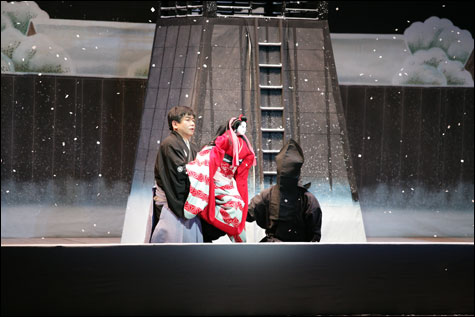
THE NATIONAL PUPPET THEATRE OF JAPAN: Becoming one individual for the duration of the
play. |
Boston hasn’t had a chance to see bunraku in more than 20 years, so the National Puppet Theater of Japan’s two performances last week were a treat for the fortunate few who could get tickets. Japan Society of Boston sponsored the show at the Cutler Majestic Theatre.
Puppets come in many forms. The ones we know best include marionettes on strings, hand puppets, and shadow puppets on long thin rods manipulated by a puppet master behind a screen. The audience isn’t meant to see the person who’s animating the dolls or the leather cutouts, and we quickly accept them as “real” humans.
Bunraku poses even more of an illusion. Each figure, half the size of a person, is propelled by three puppeteers, in full view of the audience. Two of these men are dressed in black and hooded; they move the puppet’s feet and its left side. The man who works the puppet’s head and right arm is unmasked. You see the puppet taking on life from him, as its head and gaze and gestures enact the story. But you also see that the puppeteer’s face and body reflect what the puppet is going through, as if the puppet were giving life to him instead of the other way around. Or maybe they’ve become one individual for the duration of the play.
A bunraku performance is created by an almost mystical fusion of powers: the puppeteer/puppet interaction that produces character and the telepathic coordination among the three handlers, who must have acute sensitivity to one another in order to simulate one individual’s movements. Besides that, the puppets don’t speak through the puppeteers; their dialogue is delivered by a narrator, or chanter, who sits at the side of the stage with a shamisen accompanist.
Wednesday night’s program began with a short play: Datemusume Koi No Higanoko — Hinomi Yagura No Dan. This was a sort of monologue, or possibly an excerpt from a longer play. There’s a complicated backstory we don’t see about love, honor, conspiracy. After telling her tale, building up her courage with doubts and hesitations, the heroine climbs a tower in order to ring the town fire bell. She’s trying to save her lover by creating a distraction, but she knows her heroic deed will be punished by arrest and execution. She pulls herself up the ice-covered ladder, seemingly without assistance from her managers. At last she hauls herself over the edge into the belfry and, with the puppeteer’s face looming behind her, takes a mallet and beats on the bell.
One thing I love about these puppets is the way they can do everyday things. In Tsubosaka Kannon Reigeniki, a much longer play, a housewife does some sewing as her blind husband plays the shamisen. With their tiny hands, they can pick up and fold pieces of cloth, hemstitch a garment, tweak the strings of the shamisen.